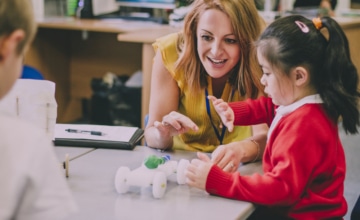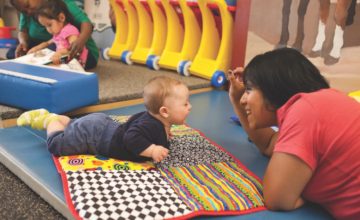Play can be a part of the child’s daily care-taking routines. When you feed, change diapers, dress, have the baby in the grocery cart or are just doing normal household chores, you can talk to, sing to, play peek-a-boo with, wiggle the baby’s toes, clap your hands or whatever appeals to you and your infant.
By Randy Lee Comfort, MSW, Ph.D, OBE
Your baby needs and wants a playmate, and you, the parent/caregiver are the very best partner your child can have. Although infants are born ready to play, they can only learn to do so by having someone else with whom to interact. Decades of research have shown that infants’ attempts to engage will diminish quite quickly if no one responds to their effortsi,ii,iii,iv. However, even small gestures such as eye contact, a smile, or a clapping of hands will encourage the baby to seek interaction.
Why Playing with Your Baby is Important:
- Through play, infants learn to socialize, take turns, share, broaden their understanding and perspectives. Very shortly after birth, infants are programmed to be capable of playing, but these neurological pathways need to be stimulated and used in order for them to grow.
- The way babies learn how to play is by having someone who will play with them to develop these skills.
- You are your baby’s favorite toy! By interacting with your infant, you are setting the stage for social, language, emotional and physical development.
- Play serves as a means of expressing ideas and feelings while learning to solve problems. It provides a space for risking and trying something new.
Play can be a part of the child’s daily care-taking routines. When you feed, change diapers, dress, have the baby in the grocery cart or are just doing normal household chores, you can talk to, sing to, play peek-a-boo with, wiggle the baby’s toes, clap your hands or whatever appeals to you and your infant. Toddlers are happily amused with kitchen toys, with mimicking grown-up tasks, with water play and with looking at books.
While some contemporary articles about playing with your baby may emphasize that it makes babies smarter, playing with your baby is best thought about in terms of forming a relationship, developing trust, and learning about social interactions. These experiences are important for learning about taking turns, delaying gratification, and developing creativity.
How You Can Play with even a Very New Baby:
- Importantly, as opposed to items you might buy to play with your baby, you are a free toy. When you smile, laugh, open and close your eyes, clap your hands, cover your face with your fingers and peek through them, your little one will be delighted.
- Your baby is looking for interaction, so when you engage in a playful way, the infant will respond. When you show your delight in his response, this turn-taking is how reciprocity gets started.
- Mimicking sounds the baby makes and/or creating your own sounds for your little one to copy are also early ways of developing interactive play, speech and engagement. Blowing bubbles helps develop eye-hand coordination as the baby watches the bubbles blowing in the wind and tries to touch them.
- Babies of even a few months of age like to have you hand them something and then give it back to you. This is the beginning of sharing and taking turns. What an important skill for your child to learn!
- You don’t have to spend a lot of money on fancy toys. Many household items can be used for play if they are safe for infants and toddlers to handle – plastic cups for stacking or nesting, boxes to crawl in and around, or pots and pans to bang on.
It is important for a baby, as with a child of any age, to feel safe when playing. Initially, very rough play, loud noises, scary faces, noises that startle are probably best avoided. Some children grow into liking these things later on, but in the beginning, a soft, gentle mode of interactive play is usually best. If a baby does not feel that the interaction is safe and fun, the baby will withdraw and not encourage further interchange.
Not all toys or games are going to be enjoyed by all children in the same way. Like food, some children will like what others do not. If your baby doesn’t seem to interact with a toy that you present, try something else. Different things will appeal to children at different ages. If nothing seems to attract the infant to engage, consider talking to your pediatrician about a hearing or visual screening or an occupational assessment to rule out any underlying health or developmental concerns.
Children with No Play Experiences are at a Disadvantage
Many children who have been in the foster care system have not had opportunities to play safely, or to play at all. This means they have not had a chance to learn the skills that go along with positive interaction and engagement with others. Not infrequently, their fine motor skills are weak because they have not had the opportunity to exercise them. Many of these children also have language delays. These developmental delays are often correctable with proper early intervention.
It is important for social workers, physicians, teachers and caregivers to recognize the adverse effects of a home-life that lacks appropriate stimulation or play opportunities. In this situation, children may respond to toys and play materials quite differently from what one might typically expect. Moreover, their cognitive impairment may have weakened the child’s ability to behave empathically, to think imaginatively or to act and respond sensitively.
How to Recognize a Child who Lacks Early Play Experiences:
- Many of these children don’t know what to do with toys. They often show little imagination about what to do with toys, and they often are unable to extend their play creatively.
- Children with no previous play interaction may not seek to engage anyone else to play with them. Although most two year olds, for example, enjoy playing with their own toys, they like to do so in the company of others – “parallel play.” In contrast, a toddler who has no shared experiences will not have achieved this level of development in his play.
- Exploration may feel very scary to a child from a compromised background so the child may just sit where placed and not look at or pick up anything new.
- The toddler may not look to the adult or to others to help with playing.
- A large number of preschoolers with no previous play experience do not use the word “pretend,” and do not know how to pretend. They may tell fantasy stories, but they do so believing they are true or wishing they were true. In contrast, typically developing three and four year olds are able to “pretend” that something is true while they know that it is not. They have the language to request or respond to the word “pretend” (Pretend you are a princess; pretend we are going to the moon; pretend you are the mean stepmother…)
- Getting dirty or messy or playing with paint, clay, water, sand, etc. may be something these children adamantly avoidv.
- Repetitive play and/or aggressive play can be very common among children who have had limited or no play experiences. While many young children can play aggressively some of the time, it may be a more common or pronounced aspect of play in children who lack appropriate play experiences. Similarly, children do like to repeat actions and activities that bring them pleasure, and a child with a wider repertoire of play experiences will expand on pleasurable activities whereas those with limited experiences do not.
- Finally, it is worth pointing out that children from compromised backgrounds generally do not like surprises. Even very, very young children feel most secure when they can predict what is going to happen next. Like other aspects of their lives, children coming from unpredictable homes need to manage their play situations. Surprises deny them this control.
Helping children who lack appropriate play experiences to learn how to play is a slow process and takes effort. It does not happen as quickly or as spontaneously as playing with children who have not experienced early trauma. Small, quiet, safe play sessions will be rewarded by the child’s growing ability to trust and to have fun.
Playing is not going to go out of style, and all children do want and love to play. It has been said that: “You don’t stop playing because you grow old; you grow old because you stop playing.vi” Playing with children is one of the earliest and best gifts to give a child.
i. Becker-Weidman, A. Child abuse and neglect: effect on child development, brain development, and interpersonal relationships. www.adoptionarticlesdirectory.com, accessed 21 August, 2007
ii. Bergen, Doris. The role of pretend play in children’s cognitive development. Early Childhood Research and Practice, vol 4 #1, 2002
iii. Brown, Stuart L. Consequences of play deprivation. Scholarpedia, 9 (5):30449, 2014
iv. Lehmann, C. Abuse said to interfere with child brain development. Psychiatric News, 37(1):23, 2002
v. Refer to: Sensory Integration Dysfunction, Tactile Defensiveness, Sexual Abuse. Kranowitz, Carol Stock. The Out of Sync Child (New York: Penguin, 2005) and The Goodenoughs Got in Sync (2010) has popularized the foundational work of A. Jean Ayres (1973) on sensory integration
vi. G. Stanley Hall, Adolescence: Its Psychology and Its Relations to Physiology, Anthropology, Sociology, Sex, Crime, Religion and Education (1904), p. 235




